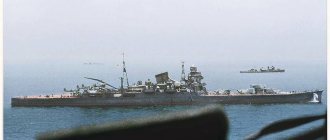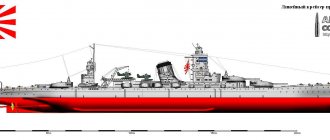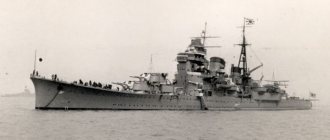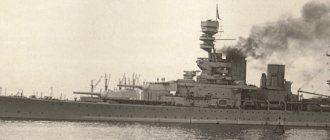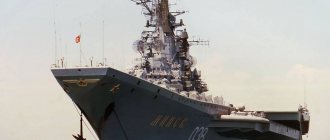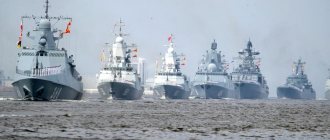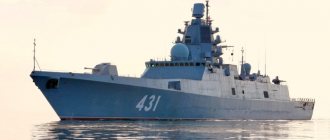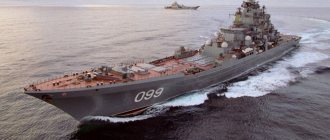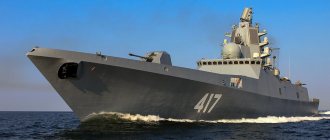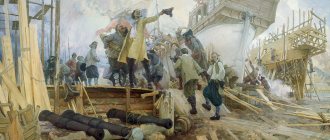Des Moines-class cruisers
Des Moines -class heavy cruisers
CA-134 “Des Moines” 28.5.45 / 27.9.46 / 11.16.48 – Removed from the list 9.7.91 CA-139 “Salem” 4.7.45 / 27.3.47 / 14.5.49 – Placed in reserve 1.59 CA-140 “Dallas” (II) 15.10.45 / – / – CA-148 “Newport News” 1.10.45 / 6.3.48 / 29.1.49 – Withdrawn from the fleet 27.6.75 CA-150 “Dallas” 15.10.45 / – / –
CA-141, 142, 143 were also ordered from Bethlehem, Quincy, but were not named, the order was canceled on 12.8.45. SA-149, 151, 152, 153 were ordered at the shipyard to Newport News, the order was canceled on 3/28/45.
Displacement: 17000 / 21500 t Dimensions: 218.39 x 22.96 x 7.92 m Machines: General Electric 4-shaft TZA; 4 Babcos-Wilcox boilers; 12000 shp = 33 knots. 3000 tons of oil = 10500 miles (15 knots). Armor: belt 102 – 152 mm; deck 95 mm; upper deck 25 mm; barbettes 160 mm; turrets 203 mm front, 102 mm roof, 95 mm sides; wheelhouse 140 – 165 mm Armament: 9 – 203/55 (3x3), 12 – 127/38 (6x2), 24 – 76/50 (12x2), 12 – 20 mm (6x2) Crew: 1799 people
The main disadvantage of the 203-mm guns was their low rate of fire, which was very noticeable in the night battles at short distances that took place in the Solomon Islands. In order to somehow improve the situation, a new rapid-fire 203-mm gun with a wedge lock and brass cartridges was created. It was assumed that its rate of fire would reach 7 rounds per minute. Work began in the spring of 1943, and the new gun appeared only towards the end of 1945. It was the 203/55 Mk 16 gun. Plans to equip the Oregon City-class cruisers with it fell through because too many modifications were required. It turned out that the design weight characteristics of the new gun were too underestimated, and the new turrets would weigh much more. A plan arose to install two-gun turrets on 4 cruisers of the CA-122 and CA-138 series, as well as cruisers CA-139 - CA-142. However, it was also not implemented. Instead, design began on a completely new tower.
The original project called for the construction of an improved Oregon City with increased thickness of deck armor. The new towers gave rise to a lot of problems, as they turned out to be much heavier than expected. An increase in the rate of fire required more spacious shell magazines. This in turn led to an increase in the length of the armor belt. As a result, the weight of the armor increased by 695 tons. More advanced fire control systems appeared, and as a result, the displacement first jumped to 16,000 tons, and then exceeded this figure.
The hull of the new ship was 12.1 m longer than that of Oregon City and 1.7 m wider. The displacement eventually reached 19,930 tons. The armor protection system differed from that used on the Baltimore-class cruisers only in the appearance of an upper armored deck, which was supposed to trigger bomb fuses before they hit the main armored deck. The 132 mm thick belt had a width of 3.05 m, and at the lower edge its thickness decreased to 88 mm. The thickness of the tower armor has been increased. Inside the hull there were 5 separate armored zones. Armored bulkheads inside the citadel were supposed to limit areas of probable damage. In general, all armor amounted to 2189 tons or 12.6%, which did not exceed the relative weight of the armor on the Baltimore. The machine installation remained the same standard 4-shaft TZA with a capacity of 120,000 shp. This resulted in a reduction in top speed. But the arrangement of the machines was different from the previously used scheme. In 3 bow compartments there was a boiler and a turbine. The fourth engine installation had separate compartments for the turbine and boiler, since the shafts of the bow engines did not allow a different arrangement. The weight of the new gun turrets reached 451 tons. They had a firing range of 150 kb at an elevation angle of 41 degrees. and could be charged at any elevation angle. The projectile weighed 152 kg. The ship's firepower was impressive - 90 rounds per minute or 13.5 tons of steel. The guidance of the guns was electro-hydraulic. Universal artillery was standard 6x2-127/38, but 4 PUAZOs appeared. At first it was planned to install 12x4 - 40 mm and 20 - 20 mm machine guns. However, at the end of the war it became clear that even a 40 mm shell could not stop a determined kamikaze, and 20 mm machine guns became practically useless. Therefore, the quad 40mm machine guns were replaced by 76/50 twins. Only “Des Moines” retained 20-mm machine guns, but they were also removed from it quite quickly. The onboard aircraft along with the catapults also quietly disappeared from the Des Moines as unnecessary. “Salem” and “Newport News” did not receive them at all. After some controversy, 12 cruisers were ordered, and the CA-134 had already been ordered as a Baltimore-class cruiser to the New York Shipbuilding Corp. The contract was transferred to the Bethlehem shipyard in Quincy, and the ship was reordered on September 25, 1943. CA-139 - CA-142 had already been ordered as Oregon City-class cruisers on June 14, 1943, but were built to a new design. SA-150 - SA-153 were ordered on February 22, 1945. The program included 3 more ships previously ordered as light cruisers - SA-143, SA-148 and SA-149. But the imminent end of the war led to a reduction in programs for the construction of new ships. On March 28, 1945, the construction of the SA-150 Dallas and SA-151 - SA-153 was canceled. At the end of the war, on August 12, 1945, work on the SA-142, SA-143 and SA-149 was stopped, but work continued on the remaining 4 cruisers. The SA-140 received the name “Dallas” instead of the canceled SA-150. At the end of 1945, the construction of all frozen ships was canceled. On January 7, 1946, construction of the SA-140 was canceled as it was in the least ready state. However, on May 27, 1946, an order followed to complete the construction of only ships with 20% readiness, after which only 3 ships remained.
Service history “DES MOINES”, “SALEM”, “DALLAS ” - These cruisers did not take part in hostilities.
NEWPORT NEWS Participated in the Vietnam War. On 10/1/72, during shelling of the coast, a shell exploded directly in the barrel of the middle gun of turret No. 2. 20 people were killed and 36 were wounded. The damaged gun was removed and the port sealed. The cruiser ended its service with a non-functional turret.
Warships. Cruisers. A charming misunderstanding
After the French heavy cruisers, one is drawn to something light and frivolous. And a better object of effort than this absurdity, perhaps, cannot be found among all the fleets of the countries that participated in the Second World War.
Frank inconsistency
Not a cruiser. Nor the destroyer leader. Never mind. Nevertheless, built in a decent series and fought from the heart - that’s what Atlanta-class cruisers are.
But let's start, as always, from the starting point.
That is, not from the Washington Agreement we mentioned earlier and the London Agreement that followed it. So let those who developed and signed these documents be indignant there themselves, and we will talk to you about more serious things. Having limited themselves and tied themselves hand and foot, countries that wanted to have powerful fleets began to look for ways to circumvent the imposed restrictions almost immediately after signing. Nobody wanted to hurt themselves.
However, with what they drew in London for a new class of light cruisers (8,000 tons of displacement and the main caliber of guns no more than 152 mm), you won’t want to, but start experimenting.
In the USA, they began to work in two directions at once - a normal, but compact universal light cruiser and a cruiser - the leader of destroyers.
Is he the leader of the destroyers?
It is the leader of the destroyers.
Many called the Atlantas “air defense cruisers,” but excuse me, what air defense ships were there in 1936? What are we talking about? These ships were designed specifically as destroyer leaders with all the attributes of this subclass. Even conceptually: actually a destroyer, but like on steroids. Almost doubled in size. The conventional leader of the destroyers that France and Italy built exceeded the displacement of conventional destroyers by a maximum of 1,000–1,500 tons. Here the situation was different, and in fact it was a full-fledged “London” cruiser, but with very unique weapons.
This ship was supposed to sail alongside destroyers at a speed of about 40 knots. And protect your ships from enemy destroyers. And also (secondarily) shoot enemy aircraft at medium distances.
And in 1936, the decision was made to create Atlanta-class cruisers. Precisely as leading cruisers, with a displacement of 6–8 thousand tons and a speed of 40 knots.
For comparison: the same age (1934), the Farragut-class destroyer had a total displacement of 2,100 tons and sailed at a speed of 36 knots. So this Atlanta is not a leader, but still a cruiser.
Armament
It was interesting with the weapons.
At first they wanted to make a combined set of four 152 mm main caliber guns in two turrets at the bow and stern. And 127-mm universal installations should be placed in the middle part of the ship. But in 1937, a decision was made not to install 152 mm guns. And make all weapons homogeneous. That is 127 mm.
Controversial decision. But the American shipbuilders realized that even a displacement of 8,000 tons (and actually less was planned) could not meet all the requirements for this ship. And something will have to be sacrificed.
All countries that signed the Treaty donated. So in this case, the Americans decided to sacrifice the main caliber. By the way, no one else did this.
They tried to implement a project with mixed weapons on Omaha-class cruisers. But even with a larger displacement than the Atlanta, nothing decent came of it.
And as a result, a cruiser with a displacement of 6,000 tons and with the main caliber of a destroyer came out.
However, 11 ships were built. And almost all of them took part in the naval battles of World War II.
What were these ships?
Booking
The reservation was carried out according to the standard American scheme: vertical and horizontal protection.
Vertical protection - an armored belt 95 mm thick with 95 mm traverses. The belt covered the engine rooms and other mechanisms. Under the water there was another armored belt, with a thickness of 95 mm at the top and 28 mm at the bottom, adjacent to the first. This belt covered the artillery magazines in the bow and stern. Horizontal armor consisted of an armored deck 32 mm thick.
The towers had an armor thickness of 25–32 mm. The conning tower on the ships had a thickness of 62.5 mm.
Overall, it’s almost a cruiser. The armor weight was 8.9% of the displacement, which corresponded to the armor level of American cruisers.
Power plant
Each cruiser was equipped with a two-shaft power plant, consisting of two turbo-gear units and four steam boilers running on oil.
The power plant capacity is 75,000 l. With. Maximum speed 32.5 knots. And the longest cruising range is 8,500 miles at a speed of 15 knots and a fuel reserve of 1,360 tons of oil.
Crew
The number of peacetime personnel was 623 people. According to the wartime staff - 820 people.
Armament
The armament in accordance with the project was the same as that of American destroyers: 127-mm universal guns, anti-aircraft guns and torpedo tubes.
The artillery armament consisted of sixteen 127-mm universal guns, located in eight two-gun turret mounts. Three towers were placed linearly at the bow and stern, and two more were located in the middle part along the sides of the ship.
This set looked very intimidating. And in theory, woe to that destroyer that gets caught in the gunfire. They would have punched it in full, but...
The “but” was that these installations (to put it mildly) did not have the proper level of impact on enemy ships. Moreover, it was impossible to identify what exactly was poorly thought out or done. Here, rather, everything should have been assessed comprehensively.
In general, the 127 mm guns were frankly rather weak. The problem was the ammunition, which was not powerful enough. Ballistics, range and accuracy suffered. The fact that with automatic supply of ammunition, according to the plan, the guns were supposed to have a rate of fire of 15 rounds per minute, and individual destroyers, when it got hot, easily fired 20-21, did not help. Statistics say that in order to shoot down one plane, the gun had to fire about a thousand shots.
It turned out that the rapid-fire guns were very “so-so” in terms of accuracy and range. Alas, this was not their only drawback. Of course, the 127 mm projectile was inferior in performance to its 152 mm counterpart, but who knows by how much! It is believed that the American 152-mm projectile was twice as superior to its 127-mm counterpart in penetration and effect.
And third. Seven towers and 14 barrels - it looks very cool, but only on paper. In fact, it was very difficult to bring them to one target to inflict maximum damage. These seven towers could fire at one target, but in a very limited sector, slightly less than 60 degrees, and even going sideways towards the enemy. Not the best position.
The firing was controlled by two new Mk37 directors at that time, which were put into service exactly in 1939. This was enough to fire at two targets. But for more, alas.
In general, the universal Atlanta caliber was indeed more suitable for shooting at aerial targets. But, as already mentioned, cruisers were not created for this at all.
"Chicago Piano"
And now about what really should have worked on airplanes.
Initially, anti-aircraft weapons were supposed to consist of 3-4 quad installations with a caliber of 28 mm. The so-called "Chicago piano". But this installation was so heavy, bulky, clumsy and unreliable that, whenever possible, they began to replace them with twin 40-mm Bofors, which were produced under license in the USA. Coaxial or quadruple 12.7 mm Browning machine guns were assumed to be used as close-combat air defense weapons. But instead of them, during the construction phase, they began to install single-barreled 20-mm anti-aircraft guns from Oerlikon.
In general, the anti-aircraft weapons of the cruisers, which were built in three series, differed from each other. If the armament of the first series consisted of 4x4x28 mm and 8x1x20 mm, then the cruisers of the third series were much richer in this regard: 6x4x40 mm + 4x2x40 mm + 8x2x20 mm.
Here, using the example of Atlanta, it can be seen that towers 1 and 3 are installed to fire at air targets. And tower No. 2 is on the surface.
Mine and torpedo weapons
Since the cruisers were supposed to operate together with the destroyers, why not launch torpedoes along with them?
Two four-tube 533 mm torpedo tubes on the sides. In general, taking into account the fact that American designers did not pamper their cruisers (more precisely, they did not clutter the decks) with torpedo tubes, the idea here is that they considered Atlanta-class cruisers as being closer to destroyers than to full-fledged cruisers. As for the name “air defense cruiser,” perhaps only ships of the third series, which entered service after the war, could claim this. Well, by the way, the US naval command began to classify these ships as Cruiser Light Anti-Aircraft, that is, an air defense cruiser, only in March 1949.
Something special
If we evaluate the project, then there are mixed feelings.
It is clear that the 30s, after Washington and London, were a time of vacillation. But here, perhaps, the Americans surpassed everyone by building something
. But really, what is “Atlanta”?
This is not a destroyer leader/counter-destroyer.
The French Jaguars had a displacement of about 3,000 tons. Italian leaders - up to 4,000 tons. And here there is twice as much of everything: displacement, weapons, people. Cruiser? No. For a cruiser, the armament and armor are frankly rather weak.
Air defense cruiser? Also no. The air defense ship clearly lacked fire control systems.
Plus, the declared speed of 40 knots turned out to be either a military trick of a misinformative nature, or something else. But 32 knots is what these ships were rich in. For full interaction with destroyers (the same Farragut produced 4 knots more), this was clearly not enough.
That's how it happened. Since something incomprehensible happened, the ships’ combat service took place in approximately the same spirit.
"Atlanta"
In fact, the combat service of this ship began in 1942.
Then the ship became part of the TF16 task force, which was based on the aircraft carriers Enterprise and Hornet. It was as part of this formation that the cruiser took part in the Battle of Midway. Atlanta didn’t get any laurels then. Since (according to the disposition) the cruiser was away from the main events. But the task assigned by the connection was completed.
Next, the cruiser’s crew conducted exercises. Among other things, they practiced shooting in squares.
On July 29, 1942, Atlanta was assigned to Task Force TF61. And from August 7, she participated in covering both the landing on the Eastern Solomon Islands and personally the aircraft carrier Enterprise.
On August 24, Atlanta entered into battle with enemy aircraft attacking the aircraft carrier. According to the captain's report, 5 planes were shot down.
Next, the cruiser was transferred to task force TF66. He carried out combat missions near Guadalcanal.
On November 12, 1942, the cruiser successfully repelled attacks by Japanese aircraft, shooting down two of them. Next was the night phase of the battle. It deserves a separate description and discussion. We will only briefly dwell on the actions of Atlanta.
Unidentified floating object
The crew of the cruiser, after detecting the enemy using radar, was the first to visually make contact with the Akatsuki destroyer, illuminating it with searchlights and literally disfiguring it from a distance of just over a mile.
Akatsuki is out of order. And, as the prisoners later showed, he did not commit any military actions until the end of the battle. Next, the cruiser engaged with two destroyers, Inazuma and Ikazuchi. He began firing at them with all 127 mm guns. But we will look at what happened next in another article in more detail.
A detective story happened. It involved an “unidentified light cruiser.” He opened artillery fire on the Atlanta.
Then the cruiser was hit by a torpedo. To the area of the bow boiler room. This causes the ship to lose speed and power supply. Stops firing from guns. And forced to switch to backup steering).
And the icing on the cake was the identified heavy cruiser San Francisco. He hit the Atlanta with about two dozen 203-mm shells. A third of the crew and Rear Admiral Scott were killed.
The story is dark, I repeat. We'll sort it out. But in fact, “Atlanta” was ruined by their combined efforts. The crew (or rather, its remnants) under the command of the excellent captain Jenkins began to struggle for survivability.
Fortunately, the minesweeper Bobolink approached and tried to tow the battered cruiser. While being towed, Japanese planes paid a visit. The heroic members of the Atlanta crew fought them off with the two remaining 127-mm guns and a pair of Oerlikons.
All this led to Jenkins ordering the ship to be abandoned. And the Atlanta sank three miles from Cape Lunga.
Honestly earned five stars. And the president’s gratitude for his courage and unbending fighting spirit. Atlanta's crew was obviously very good.
"Juno"
The fate of this cruiser was even shorter.
Juneau took part in the rescue of the crew of the USS Wasp, which was sunk by a Japanese submarine on September 15, 1942. He was then assigned to Task Force TF17, where he participated in the raid on the Shortland Islands and in the battle near the Santa Cruz Islands. At the beginning of November 1942, as part of the TG62.4 formation, it covered the transition of convoys from Noumea to Guadalcanal.
In a night battle (in which the Atlanta was destroyed), on November 12, 1942, he was hit by a torpedo on the left side in the area of the bow boiler room. With a large roll at low speed, he tried to leave the battlefield. But north of Guadalcanal he received another torpedo in the area of the bow magazines from the Japanese submarine I-26.
The ammunition detonated. And the cruiser sank within 20 seconds.
Only 10 people were saved.
"San Diego"
He first took part in battles during the Battle of the Solomon Islands.
Participated in the raid on the Shortland Islands. In the battle near the Santa Cruz Islands. In the summer of 1943 he supported the landing on New Georgia. Participant in the landing operation on the Gilbert Islands, the raid on Kwajallein, attacks on Japanese bases in the Marshall Islands and Truk, and the landing on Enewetak Atoll.
In 1944, he took part in the raids on Marcus and Wake. Covers the landing on Saipan. And also in the battle in the Philippine Sea. And in the landings on Guam and Tinian. In addition, in attacks on Palau and Formosa.
16 battle stars.
"San Juan"
The cruiser joined Task Force TF18 in June 1942 in San Diego.
Accompanied a convoy of troops to the Solomon Islands for the landing on Tulagi. Participated in the battle of Santa Cruz. There it was damaged by a bomb. It went right through the stern. But it didn't explode.
Participated in the raid on Kwajallein, attacks on Palau, Yap, Ulithi, and the landing in Holland. In the summer of 1944 he was in action in the Philippine Sea. In December 1944 - in operations in the South China Sea, off Formosa, in attacks on the Philippines. In March 1945 - in attacks on Iwo Jima and Okinawa.
13 battle stars.
Oakland, Renault, Tucson and Flint
The second series cruisers Oakland, Renault, Tucson and Flint entered service in 1944. And they did not take part in the war as actively as the ships of the first series. However, these ships also had successful operations.
Results
To summarize all that has been said, it is worth saying that the ships, in principle, with a proper understanding of their tasks and capabilities, were suitable for use.
Another thing is that there wasn’t really a well-thought-out niche for them, which is why they couldn’t be used effectively. A cruiser that has problems with armor and firepower is not a cruiser. A destroyer leader who is unable to catch up with his charges is not a leader. And, frankly speaking, the American Fletchers and Gearings were excellent and powerful destroyers that did not need nannies.
Only the third, post-war Atlanta series could be considered as air defense ships, because they already had 6 control directors instead of two.
In general, “Atlanta” is a familiar product of compromises. Generated by the Washington Papers.

